Since 2019, the “Asia Maritime Transparency Initiative” (AMTI) at the Center for Strategic and International Studies (CSIS), a US think tank, has repeatedly released reports alleging that since mid-2018, China’s rallying maritime militia is aimed at monitoring or even blocking the Philippines’ construction operations in Thitu Island and other islands and reefs. This has raised widespread attention in the Philippines and international community, and also disrupted sound and stable Sino-Philippine relations. To better understand the crisis, this paper attempts to review and analyze the issue based on facts and logic for readers’ reference.
1.AMTI: Hundreds of Chinese Fishing Vessels and Maritime Militia
This January, CSIS released a report titled Illuminating the South China Sea’s Dark Fishing Fleets, saying that results from several technologies including Automatic Identification System (AIS), Synthetic Aperture Radar (SAR), and Visible Infrared Imaging Radiometer (VIIRS) showed that large-scale Chinese fishing vessels were gathering at Subi Reef and Mischief Reef of Spratly Islands. In August 2018, the busiest month, about 300 vessels anchored there. Among them, ten vessels were assembled in waters near Thitu Island, Loaita Island, and Itu Aba Island(Taiping Island). The report concluded that these vessels, not for fishing activities, actually serve in China’s “maritime militia,” which primarily engages in “paramilitary activities” including patrol, surveillance, and resupply in a bid to bolster China’s presence in the South China Sea.
On February 6, AMTI issued a report on its official website titled Under Pressure: Philippine Construction Provokes a Paramilitary Response, further alleging that the Philippines started repair work on the runway at Thitu Island of Spratly Islands in May 2018 and that in mid-December, it had begun to create a “beaching ramp” on the west coast of the island which would allow ships with deeper drafts to better deliver supplies. As a result, the report stated that it is likely to be China’s response to the Philippine construction efforts by deploying naval vessels, coast guard vessels, and fishing vessels with militia members from Subi Reef over 12 nautical miles southwest of Thitu since July 2018. The number of Chinese vessels increased to at least 24 on December 3, just before Philippine construction began on the beaching ramp; the number reached 95 on December 20 before dropping to 42 by January 26, 2019.
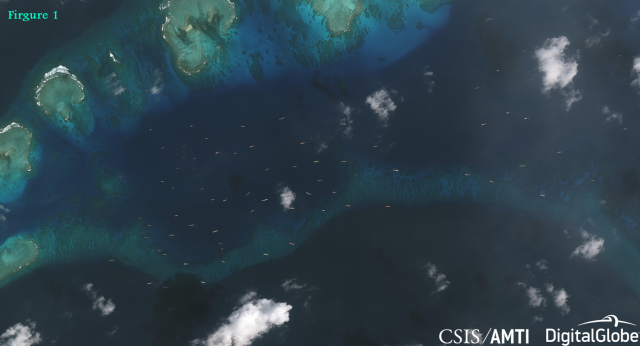
Figure 1 Satellite image captured on December 20, 2018 from the AMTI report
The report holds that China is still following a “cabbage strategy,” which means that the fishing vessels have mostly been anchored between 2 and 2.5 nautical miles west of Thitu Island, while naval and coast guard vessels operate slightly farther away to the south and west. This deployment employs concentric layers of fishing, law enforcement, and naval vessels around these areas.
On April 16, AMTI issued another report saying that since early March 2019, Chinese fishing vessels have been operating near the Philippine-held Loaita Island and Loaita Cay in Spratly Islands, and that the number of Chinese vessels has risen from one on March 12 to 15 on March 29. According to the report, these large 50-meter-long trawlers either show no signs of fishing but indication of belonging to maritime militia, or are often seen harvesting giant clams by intentionally destroying coral reefs around the South China Sea. The report concluded that the maritime militia is and will likely remain the most visible arm of China’s power directed at its neighbors in Spratly Islands. This perspective and logic are consistent with those in the previous reports about Thitu Island:
A large number of vessels were found gathering on relevant islands and reefs, which must have come from China and most of which are fishing vessels carrying maritime militia.
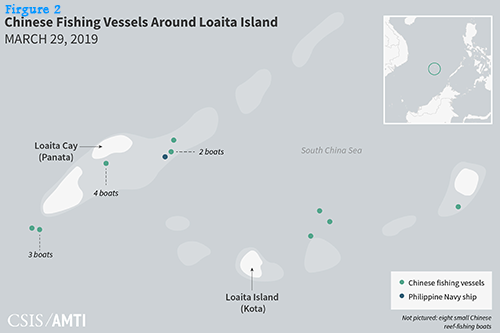
Figure 2 Vessels around Loaita Island on March 29, 2019 from the AMTI report
2.The Philippines takes a tougher stance, but China remains rational
At first, little attention was paid to these reports in the Philippines except for some quotations and reports from some media, such as the highly circulated Inquirer and Philstar, and the Philippine government maintained rational and objective.
On February 14, Salvador Panelo, the Philippine Presidential Spokesman, said in response to a reporter’s question that the Department of National Defense of the Philippine government had launched an investigation and confirmed that Chinese fishermen (vessels) can retain the same fishing rights as Philippine fishermen (vessels). On the same day, Benjamin Madrigal Jr., Chief of Staff for the Armed Forces of the Philippines, clarified that the Philippine construction of a beaching ramp had not been hampered by the presence of the Chinese vessels. On March 5, Rene Medina, Vice Admiral and commander of the Armed Forces’ Western Command (WesCom), once again stated in response to questions from the Kalayaan Mayor and media that they had not received reports of Philippine fishermen being prevented by Chinese vessels from fishing around Thitu Island, but there were about ten Chinese vessels anchored near the islands. He also said that these Chinese vessels were actually military militia to monitor the fishing boats.
However, since late March and early April, public opinion on the “Thitu Island issue” in the Philippines has been further stirred up. On March 29, WesCom made public that over 600 Chinese vessels had been simply circling Thitu Island since January this year. On February 10, when the Armed Forces of the Philippines brought construction equipment to the island to fix the facilities there, there were as many as 87 Chinese vessels. The Philippine military said that these vessels were considered Chinese maritime militia and were occasionally complemented by Chinese Coast Guard vessels to maintain China’s assertive presence. On April 1, the Philippine military also claimed that more than 200 Chinese vessels were operating near Thitu Island and the Department of Foreign Affairs of the Philippines issued a diplomatic representation to China afterwards.
Since then, the Philippine government has taken a tougher stance. On April 2, Panelo claimed that Chinese fishing vessels could stay in the disputed waters near Thitu Island, but the “paramilitary forces” had to leave. After that, Foreign Affairs Secretary of the Philippines Locsin added that the Arbitration Tribunal (Philippines v. China Case) had already ruled that the Philippines has sovereign rights over the “West Philippine Sea”, and that the presence of Chinese vessels near Thitu Island was illegal and violated Philippine sovereignty. Thus, the Philippine government held that sovereignty cannot be negotiated and that it would take tougher measures in its relations with China if China refused to respond correctly to the Philippine diplomatic protest. It even suggested that President Duterte might discuss Thitu Island vessel issues with Chinese representatives during his visit to China.
Confronted with instigated public opinion across the nation, the Philippine President Duterte publicized on April 4 that if China touched Thitu Island, he would tell his soldiers to “prepare for a suicide mission.” But he also admitted that the Thitu Island issue had “something to do with the greater game of geopolitics. And it is not directed at us.”
Since the very beginning, China has always exercised restraint to avoid any escalation. While maintaining communication with the Philippines, China has also positively responded and made clarification to the Philippines and the international community. On April 1, the Chinese Ambassador to the Philippines Zhao Jianhua clarified that the Chinese vessels near Thitu Island were only fishing and completely unarmed, though the number of these boats was yet to be ascertained. The Ministry of Foreign Affairs of PRC has also made it clear that Chinese fishing vessels around Thitu Island are legitimate and have not changed much compared to previous years.
3.Fact: Thitu Island Crisis?
Since the “Thitu Island Crisis” arose, both Chinese and Philippine governments have verified the information contained in the US think tank’s report, and the “fiction” and “fact” of the issue have gradually come out in the wash.
Firstly, activities of Chinese vessels in the area this year, as clarified by the Chinese government time and again, are not much different from those in previous years. In terms of technology, the remote sensory image of Thitu Island taken by the Chinese satellite “SuperView-1” on December 26, 2018, compared to satellite images simultaneously released by AMTI, shows that there were no vessels around Thitu Island except for two fishing vessels in the southwest sailing northwest. According to the images released by AMTI, the numerous vessels are actually in the lagoons around Thitu Island, which is still far away from Thitu Island. Obviously, the so-called “Thitu Island Crisis” is nothing but a pure conjecture based on the wrong interpretation of remote sensing image.
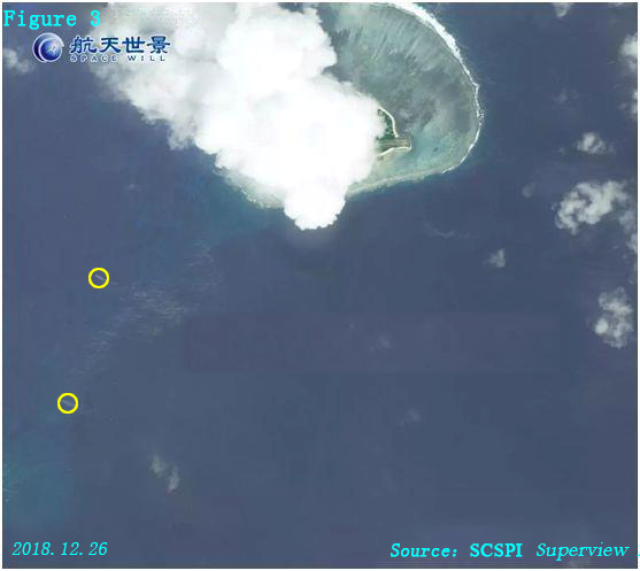
Figure 3 Remote sensory image of Thitu Island taken by the Chinese satellite “SuperView-1” on December 26, 2018
It should be noted that the vessels operating in the waters around Thitu Island are dynamic, which to a large extent largely depends on the specific time of our observation. There are vessels sailing in and out of the lagoons almost every day, and the number of vessels varies greatly from day to day, even from time to time on the same day. Even in hot time of the crisis, 9 and 14 vessels operated in the lagoon according to satellite images taken on April 4 and 14, which is a big change but still far away from the reported “100 vessels encircling around Thitu Island”(see image below).
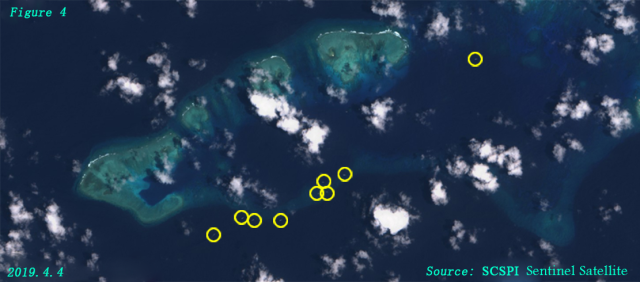
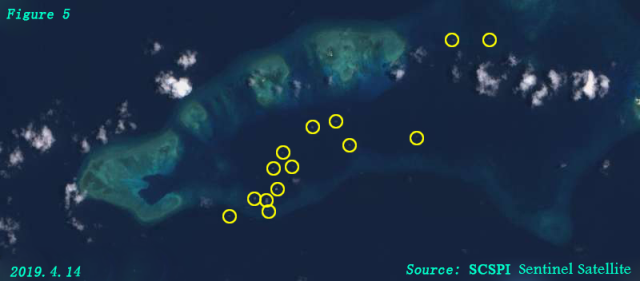
In fact, the Department of National Defense of the Philippine government has repeatedly verified that there are not as many as 100 Chinese vessels around Thitu Island. AMTI’s report seemed to highlight December, which appeared to show the largest fluctuation in the quantity of Chinese vessels; however, the increased number in December was due to rising demands for marine products during the upcoming traditional Chinese Spring Festival. Therefore, the occasional numerous vessels mentioned in the AMTI report were more likely to be a cluster of fishing vessels, while a few public service vessels from the coast guard were there to supervise the fishing operations.
Frankly speaking, due to predatory fishing by neighboring nations, fishery resources in the South China Sea have reduced considerably, and the ecosystem has also been gradually disrupted, leading to plummeting fishable resources. Against this backdrop, the number of Chinese fishing vessels is unlikely to increase. Moreover, there are also vessels from Vietnam, the Philippines, and other nations operating in the lagoons around Thitu Island, and satellite images alone cannot tell the nationality of such vessels.
The lagoons around Thitu Island are traditional fishing grounds for Chinese fishing vessels. Apart from Thitu island, Chinese stationed Subi Reef is also nearby. It is completely normal to see fishing vessels, coast guard vessels, and naval vessels in this area.
Secondly, the conclusion that most of the vessels are “maritime militia vessels” is wild conjecture. AMTI’s report intentionally associated the activities of Chinese vessels with the Philippines’ construction on Thitu Island and presumed without on-site confirmation that the Chinese vessels were “maritime militia vessels.” According to the report, satellite images reveal that many vessels anchored there show no signs of trawling or fishing gear deployed in the sea, and many Chinese vessels are unable to be identified by the automatic identification system (AIS), all of which match maritime security forces. Objectively speaking, however, as analyzed by the Singaporean scholar Zhang Hongzhou, not all fishing vessels, given constraints from technology and economic benefits, are equipped with AIS. Based on the author’s own field investigation, many Chinese fishing vessels in Spratly Islands have still not been equipped with AIS. On the other hand, fishing operations by Chinese fishermen (vessels) are many and various. Except for large trawling ships, most Chinese fishing vessels, restricted by fishery resource distribution and natural geographical conditions, conduct traditional fishing operations like night fishing under lights and underwater fishing. Furthermore, fishing in sensitive waters will be subsidized by many coastal states around the South China Sea. Therefore, it cannot be ruled out that some fishing vessels anchored in the lagoons are seeking financial subsidy. Without conducting field investigations or taking into consideration the complexity of local fishery environments and operation methods, AMTI’s report asserts that China has deployed numerous “maritime militia vessels” in this area, which is unconvincing, and it will only escalate tensions.
Thirdly, the Philippines’ reaction was not forced by the pressure from the situation of Thitu Island, but aimed at calming widespread public opinion at home. According to public information, it is easy to know that since 2019, there has been no crisis like a China-Philippines confrontation around Thitu Island. Both sides have taken precautions against each other by dispatching public service vessels there, which, chiefly for alert, is a common tactic. This is not difficult to know from the reactions of the two parties. As stated by the Secretary of National Defense Delfin Lorenzana on February 4, the beaching ramp at Thitu Island was originally scheduled for completion in 2018, but the construction had been delayed by inclement weather and rough seas, so the delay has nothing to do with China. Meanwhile, according to its investigations, the Philippine military has indicated that no interference by Chinese vessels in its freedom of movement in Thitu Island and waters around is found.
But since the end of March, with burning public debate on the issue at home and abroad, the Philippine authorities have started to take a tough stance. Even so, the Philippines have not given new evidence or information, but rather repeated what AMTI and other Western media said and showed its toughness and determination to defend its sovereignty. It is worth noting that the AMTI’s report, though full of loopholes, easily inflamed public sentiment in the Philippines.
4.Conclusion and Reflection
It is not big news nor worth making a fuss that China and the Philippines have disputes over some islands and reefs in the Spratlys, including Thitu Island. And it is common to see that fishing vessels, public service vessels, and naval vessels from the two nations frequently have various interactions in the disputed waters.
The natural geographical conditions of the South China Sea are extremely complex, and coastal states often conduct active and diverse maritime activities in this area. Even governments of such nations cannot understand entirely the geology and geography, resource distribution, and humanities and social existence in the South China Sea,may also be impossible to fully grasp the details of fishing vessels in the region. Thus, we should maintain modesty in observing the South China Sea, and take into full account the complexity of the situation. We shall not fondly hold that we have discovered the truth simply through a few satellite images, let alone hyping the issue with ulterior motives.


